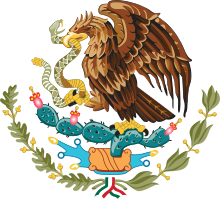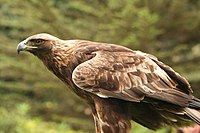National symbols of Mexico

The national symbols of Mexico are the flag, the most coat of arms and the anthem. The flag is a vertical tricolor of green, white, and red. The coat of arms features a golden eagle eating a snake on top of a cactus.
National flag
The current national flag was changed from a front-facing to a side-facing position.
The colors of the flag originated from the banner of the Army of the Three Guarantees, which lasted from 1821 until 1823. Originally, the colors had the following meanings:[3]
- Green: Independencia (independence from Spain)
- White: Religión (religion, the Roman Catholicfaith)
- Red: Unión (union between the Europeans and Americans)
However, the meaning of the colors changed because of the
- Green: Hope
- White: Unity
- Red: Blood of the national heroes
The World Encyclopedia of Flags, a book written by Alfred Znamierowski, also gives the following meaning to the colors of the flag:[3]
- Green: Hope
- White: Purity
- Red: Religion
Since Article 3 of the Flag Law does not give an official symbolism to the colors, other meanings may be given to them. Other groups have used the national colors as part of their own
Coat of arms

According to the official story of Mexico, the

A closer look at the original
The bird featured on the Mexican coat of arms is the
National anthem


The National Anthem of Mexico (
At the same time the lyrics were composed, a set of music was chosen, the winner was
The modification of the lyrics was ordered by President
Official logo of the government of Mexico



In the image the characters appear, that López Obrador has qualified as his references on various occasions. These are
Female version

A new official logo featuring prominent women in the country's history on the occasion of the commemoration of
References
- ^ Juán López de Escalera Diccionario Biográfico y de Historia de México, Editorial del Magisterio, México, 1964.
- ^ Universidad de Guadalajara "History of the Mexican Flag" [1] Archived 2007-08-15 at the Wayback Machine. (es)
- ^ ISBN 0754801675.
- ^ Benito Juárez's biography on the website of former President Ernesto Zedilo Archived 2006-06-15 at the Wayback Machine
- ^ Christian Science Monitor article on the PRI logo controversy[permanent dead link]
- ^ Embassy of Mexico in Serbia and Montenegro Mexican Symbols—Himo Archived 2009-09-11 at the Wayback Machine. Retrieved Mar. 19, 2006.
- ^ Administration of Ernesto Zedillo National Symbols of Mexico Archived 2006-04-25 at the Wayback Machine. Retrieved Mar. 15, 2006.
- Diario Oficial de la Federación—Decree allowing for translation of the anthem into native languages. Dec. 7, 2005. Retrieved Jan. 11, 2006
External links
- Official symbols of Mexico (in Spanish)
